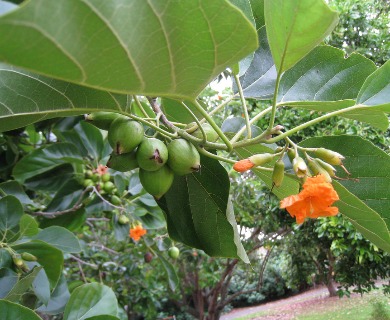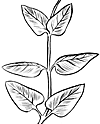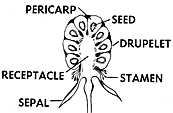Kou
Cordia subcordata
Cordias family (Cordiaceae)
Native species (indigenous)
This is a small tree with a broad uncommon along shores, and apparently predates early Hawaiians. Characterized by large broad to elliptical blunt-pointed leaves and showy large funnel-shaped orange flowers. To about 26 ft (7 ) high and 15 inches (38 ) in trunk diameter, reported to reach a somewhat larger size formerly. Bark gray, thick rough, furrowed into narrow ridges. Twigs stout, light gray, sometimes hairy, with raised half-round leaf-scars.

©2009 Wendy Cutler
Flower clusters ( or ) and lateral, short, about 2 inches (5 ) long. Flowers are several, short-stalked, showy, about 1 1⁄4 inches (4 ) long and broad. cylindrical, fleshy, yellow green, 5⁄8 inch (15 ) long, with 3–5 short broad teeth; orange, funnel-shaped with 5–7 rounded slightly wrinkled 5–7, threadlike, inserted in tube and slightly longer; and with conical 4-celled and slender orange branched twice near
() several, egg-shaped, 1 inch (2.5 ) long, enclosed by the brown with teeth and base of at green, becoming dry and brown, with large hard stone. Seeds four or fewer, white, about 1⁄2 inch (13 ) long, narrow.
Sapwood is pale yellowish brown and heartwood is light brown prominently marked by dark brown or black streaks in the growth rings. Figure resembles that of “Circassian” walnut. Lightweight ( gr. 0.45), soft, easily worked, durable, and takes a fine polish. It was used by the Hawaiians for their handsome bowls, cups, and dishes. The wood was favored for utensils because it did not impart a flavor to foods as do koa and other native woods. It is still used occasionally for craftwood but is in very short supply.
Formerly, this very useful tree was more common as a shade tree of rapid growth around houses and along the shore. The flowers were made into necklaces or leis, and the seeds were eaten. Many trees were destroyed by moths.
In Hawaii, scattered through the islands along shores, both humid and arid, and planted as an ornamental. Recorded from Niihau. As further evidence of introduction, Degener noted that fossil pollen of this species had not been found in Hawaii and that no peculiar or insects were found on the trees here.
Trees may be seen at Kualoa Beach, Maui Zoological and Botanical Garden, and in many other places. One of the largest kou trees in Hawaii grows in front of the Pauhana Inn at Kaunakakai, Molokai.
Special areas
Waimea Arboretum, Foster, lolani, City
Range
Now cultivated and established from eastern Africa and tropical Asia through Malaya to tropical Australia and Pacific Islands. Possibly distributed to Hawaii and other islands by early inhabitants. Or by ocean currents.
Kou is often confused with the more recently introduced kou-haole or Geiger-tree, Cordia sebestena L., which is smaller in size and has smaller, rough textured leaves, white and darker orange flowers.
Other common names
koa (Guam); niyoron (N. Marianas); kalau (Palau); galu (Yap); anau (Truk); ikoik (Pohnpei); ikoak (Kosrae); tauanave (Am. Samoa)









